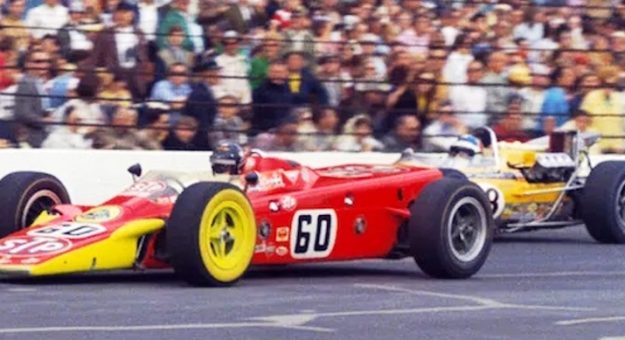As the 1968 Indianapolis 500 approached, chatter concerning the construction of multiple turbine-powered cars dominated the pre-race narrative.
The year before Andy Granatelli had upended the sport with his four-wheel-drive, turbine-powered machine, dubbed “Silent Sam.” Parnelli Jones was nearly a full lap ahead of eventual winner A.J. Foyt when his turbine-powered car coasted to a stop four laps short of the checkered flag due to a failed transmission bearing.
The outcry against the “jet” engine was deafening.
Fans, though fascinated by the technology, wanted cars that roared not whooshed. Car owners were terrified about the possibility of millions of dollars in equipment becoming obsolete.
USAC quickly addressed their fears by drastically reducing the size of the turbine’s air-intake. In turn, an outraged Granatelli brought six lawsuits against USAC.
While lawyers battled, Granatelli commissioned Lotus guru Colin Chapman to build four turbine-powered cars for the 1968 500. Designated Lotus 56s, the cars were four-wheel-drive, wedge-shaped machines that demonstrated in early testing that a turbine would again be the car to beat at Indianapolis.
Jim Clark, who tested the cars, told friends, “I just drove the car that will win the Indianapolis 500.” Tragically, Clark died April 7 in a Formula 2 race at Germany’s Hockenheimring.
Jackie Stewart inherited Clark’s car, joining an impressive team of drivers that included Graham Hill, Mike Spence and USAC sprint car champion Greg Weld.
Granatelli’s turbine onslaught was joined by Cobra developer Carroll Shelby. He entered three Ken Wallis-designed cars, naming Bruce McLaren and Denny Hulme as the drivers.
One driver who turned down a turbine was Bobby Unser.
“Andy offered me $150,000 to drive one and 50 percent of the prize money,” Unser claimed. “But I said no. I wouldn’t have taken a million to step away from Bob Wilke’s team.”
A wise decision, as Wilke provided Unser with a new Offy-powered Gurney Eagle. It was a combination many believed would defend the establishment against the turbine challenge.
When practice began the Granatelli turbines were fast. Especially Mike Spence’s. He touched the 170 mph mark on only his third practice day.
His racing line was radical, however, and while testing Greg Weld’s car on May 7, it bit him. The ensuing crash left Spence unconscious. He died that evening.
Chapman, crushed by the loss of Clark and Spence, left Indy saying, “I’m done with the speedway.”
The day after Spence’s death, a mystery occurred that remains unsolved. Shelby’s high-profile turbine team disappeared. Overnight, without comment, the cars vanished and the garages were padlocked.
Rumor had it that the cars contained a device that circumvented the restrictive engine intake opening and Shelby pulled the cars before USAC could examine them closely.
When Stewart broke his wrist in a F-2 race, the door opened for Joe Leonard to drive a turbine, while Art Pollard took over Weld’s troublesome car.
With the driver lineup settled, the turbines dominated Pole Day. Hill qualified early, breaking the 170 mph barrier at an astounding 171.208 mph. Chapman, who’d returned to the speedway, broke down during a post-qualifying interview saying, “This is what Jimmy and Mike would’ve wanted.”
Leonard ran even faster and claimed the pole at 171.559 mph, while Unser became the “best of the rest” when he grabbed the outside spot in row one.
On race day, Leonard immediately took the lead, but with Unser in close pursuit. Though running smoothly, Leonard was struggling.
With his turbine detuned following qualifying, he could handle the competition through the corners because of four-wheel drive. However, passing slower cars down the straights was another story. The wily Unser took full advantage of that as the duo worked lapped traffic.
But Unser also had problems. He’d lost all but fourth gear, allowing Leonard to gain ground with every painstakingly slow pit stop. When what proved to be the final yellow flag waved, he was several seconds behind Leonard.
Although the race looked to be Leonard’s, Unser believed he still had a chance, calculating he could overtake him on the last lap. But that drama never unfolded. When the green flag waved, Leonard’s turbine inexplicably died, and Unser raced to his first 500 victory.
Afterward, a disconsolate Granatelli, who’d come tantalizingly close to victory in two consecutive 500s, lamented, “Does it matter what went wrong? It just wasn’t my time. But I’d bet USAC tries to ban the turbines.”
USAC effectively did just that, once more slashing the size of the turbine’s air-intake opening.
As unexpectedly as it began, one of one of the most dramatic, controversial and innovative eras in Indianapolis history was finished.
